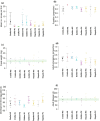Expansion to new habitats and a new commercial host (Malus domestica) by Anastrepha ludens (Tephritidae) likely influenced by global warming
- PMID: 39533054
- PMCID: PMC11557875
- DOI: 10.1038/s41598-024-78727-2
Expansion to new habitats and a new commercial host (Malus domestica) by Anastrepha ludens (Tephritidae) likely influenced by global warming
Abstract
Anastrepha ludens (Mexican fruit-fly) is a highly polyphagous fruit fly species (Tephritidae) attacking wild and commercial fruit from Mexico to Panama. Here we report on a recent habitat and host range expansion as A. ludens lately started to attack apples (Malus domestica) in Mexico, a phenomenon likely influenced by global warming. We document natural infestations in apple-growing regions in the States of Nuevo León and Hidalgo, Mexico where A. ludens has started to attack the cultivars 'Golden Delicious', 'Rayada' and 'Criolla'. No infestations were found in the apple-growing region of Zacatlán, Puebla. To determine apple cultivar susceptibility to the attack of this emerging pest, we ran forced infestation assays in enclosed fruit-bearing branches in all three apple-growing regions and studied the metabolome of all fruit. A clear pattern emerged indicating that the cultivar 'Golden Delicious' was the most susceptible, with 'Criolla' exhibiting complete resistance in one location (Puebla). Although A. ludens can develop in this new host, development rates (egg-adult) and adult emergence were affected when compared with the performance in the natural host 'Marsh' grapefruit. Warmer temperatures and specific secondary metabolites of some apple cultivars are likely contributing to the territorial and host expansion of A. ludens.
Keywords: Apple metabolome; Habitat and host-range expansion; Mexican fruit-fly; Pest management; Warmer temperatures.
© 2024. The Author(s).
Conflict of interest statement
Figures








Similar articles
-
Limits to the host range of the highly polyphagous tephritid fruit fly Anastrepha ludens in its natural habitat.Bull Entomol Res. 2015 Dec;105(6):743-53. doi: 10.1017/S0007485315000711. Epub 2015 Sep 7. Bull Entomol Res. 2015. PMID: 26343267
-
Effect of Resin Ducts and Sap Content on Infestation and Development of Immature Stages of Anastrepha obliqua and Anastrepha ludens (Diptera: Tephritidae) in Four Mango (Sapindales: Anacardiaceae) Cultivars.J Econ Entomol. 2017 Apr 1;110(2):719-730. doi: 10.1093/jee/tow279. J Econ Entomol. 2017. PMID: 28073981
-
Nonhost status of commercial Persea americana 'Hass' to Anastrepha ludens, Anastrepha obliqua, Anastrepha serpentina, and Anastrepha striata (Diptera: Tephritidae) in Mexico.J Econ Entomol. 2004 Apr;97(2):293-309. doi: 10.1603/0022-0493-97.2.293. J Econ Entomol. 2004. PMID: 15154448
-
Susceptibility of 15 mango (Sapindales: Anacardiaceae) cultivars to the attack by Anastrepha ludens and Anastrepha obliqua (Diptera: Tephritidae) and the role of underdeveloped fruit as pest reservoirs: management implications.J Econ Entomol. 2014 Feb;107(1):375-88. doi: 10.1603/ec13045. J Econ Entomol. 2014. PMID: 24665723
-
Host marking pheromone (HMP) in the Mexican fruit fly Anastrepha ludens.Chimia (Aarau). 2010;64(1-2):37-42. doi: 10.2533/chimia.2010.37. Chimia (Aarau). 2010. PMID: 21137682 Review.
References
-
- Thackeray, S. J. et al. Phenological sensitivity to climate across taxa and trophic levels. Nature535, 241–245. 10.1038/nature18608 (2016). - PubMed
MeSH terms
Grants and funding
LinkOut - more resources
Full Text Sources
Miscellaneous

